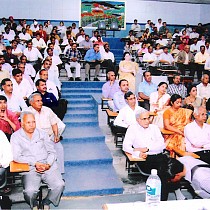ANTIXENOTIC RESISTANCE TRAITS OF MUSKMELON (CUCUMIS MELO L.) AGAINST FRUIT FLY (BACTROCERA CUCURBITAE (COQUILLETT)) IN ARID REGION OF INDIA
Scientists, ICAR-Central Institute for Arid Horticulture, Sri Ganganagar Highway, Beechwal Industrial Area, Bikaner — 334006
SHRAVAN MANBHAR HALDHAR', BALU RAM CHOUDHARSP, RAKESH BHARGAVA
Plant genotypes possess different antixenotic properties, which resultantly induce in them different mechanisms of resistance. Various antixenotic traits including length of pubescence, fruit toughness, rind thickness, flesh thickness, days to first harvest and fruit diameter were studied on eleven genotypes of muskmelon (Cucumis melo L) in relation to resistance against B. cucurbitae under field conditions in the hot arid region of India. Significant differences were observed in the tested genotypes for fruit infestation and larval density per fruit. AHMMTBR-1, RM-50 and AHMM/13R-8 were resistant; MHY-5, Durgapura Madhu and Pusa Sarabati moderately resistant; AHMM/BR-13, Pusa Madhuras and Arka Jeet susceptible; while, Arka Rajhans and GMM-3 were the highly susceptible genotypes to fruit fly infestation. Spositive correlation (r = 0.97) was observed between per cent fruit infestation and larval density per fruit. The percent fruit infestation and larval density had significant positive correlations with Suit diameter and days to first harvest and negative correlation with fiuit toughness, rind thickness, flesh thickness and length of ovary pubescence. Maximum variation in fruit infestation and larval density was explained by length of ovary pubescence (63.3 and 45.7% respectively) followed by fruit toughness (6.7 and 13.7% respectively) and fruit diameter (8.6 and 10.5% respectively).


